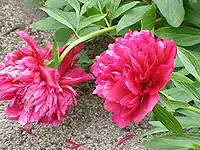Peonidin
Peonidin is an O-methylated anthocyanidin derived from Cyanidin, and a primary plant pigment. Peonidin gives purplish-red hues to flowers such as the peony, from which it takes its name, and roses. It is also present in some blue flowers, such as the morning glory.
 | |
| Names | |
|---|---|
| IUPAC name
2-(4-Hydroxy-3-methoxyphenyl)chromenylium-3,5,7-triol | |
| Identifiers | |
3D model (JSmol) |
|
| ChEBI | |
| ChEMBL | |
| ChemSpider | |
| KEGG | |
PubChem CID |
|
| UNII | |
| |
| |
| Properties | |
| C16H13O6+ | |
| Molar mass | 301.27 g/mol |
Except where otherwise noted, data are given for materials in their standard state (at 25 °C [77 °F], 100 kPa). | |
| Infobox references | |

Like most anthocyanidins, it is pH sensitive, and changes from red to blue as pH rises because anthocyanidins are highly conjugated chromophores. When the pH is changed, the extent of the conjugation (of the double bonds) is altered, which alters the wavelength of light energy absorbed by the molecule. (Natural anthocyanidins are most stable in a very low pH environment; at pH 8.0, most become colorless.) At pH 2.0, peonidin is cherry red; at 3.0 a strong yellowish pink; at 5.0 it is grape red-purple; and at 8.0 it becomes deep blue; unlike many anthocyanidins, however, it is stable at higher pH, and has been isolated as a blue colorant from the brilliant "Heavenly Blue" morning glory (Ipomoea tricolor Cav cv).
Because of its unusual color stability, a cafeyl-acylated buffered formulation of it has been patented for use as food coloring.
Peonidin, like many anthocyanidins, has shown potent inhibitory and apoptotic effects on cancer cells in vitro, notably metastatic human breast cancer cells.[1] A very large question, however, has been raised about anthocyanidins' penetration and retention in human cells in vivo, due to their rapid elimination from the human body.
By far the greatest dietary source of peonidin is raw cranberries, which contain 42 mg per 100 g of fruit. Blueberries, plums, grapes, and cherries also contain significant amounts, ranging from 5 to 12 mg/100 g. Only fresh fruit has been shown to contain significant peonidin; frozen blueberries have been shown to contain almost none. Peonidin has been found in concentrations of up to 40 mg per 100 g (cooked) of certain cultivars of purple fleshed sweet potatoes; the amount of peonidin varies greatly across cultivars.[2] It has also been isolated from raw black rice and black bananas.
The higher level of peonidin in fresh fruit corresponds to the rule of thumb that more natural fruit is healthier. Specifically, the amount of phenolic compounds in cranberries has been found to be inversely correlated with fruit size and crop yield.[3]
List of peonidin derivatives
- Peonidin-3-O-glucoside, found in red onion
References
- Jung Yeon Kwon; Ki Won Lee; Haeng Jeon Hur; Hyong Joo Lee (2007). "Peonidin Inhibits Phorbol-Ester-Induced COX-2 Expression and Transformation in JB6 P+ Cells by Blocking Phosphorylation of ERK-1 and -2". Annals of the New York Academy of Sciences. 1095 (1): 513–520. doi:10.1196/annals.1397.055. PMID 17404064.
- Van-Den Truong; Nigel Deighton; Roger T. Thompson; Roger F. McFeeters; Lisa O. Dean; Kenneth V. Pecota & G. Craig Yencho (2009). "Characterization of Anthocyanins and Anthocyanidins in Purple-Fleshed Sweetpotatoes by HPLC-DAD/ESI-MS/MS" (PDF). Journal of Agricultural and Food Chemistry. 58: 404–410. doi:10.1021/jf902799a. PMID 20017481. Archived from the original (PDF) on 2010-07-12.
- N. Vorsa; J. Polashock; D. Cunningham; R. Roderick; A. Howell. "Evaluation Of Fruit Chemistry In Cranberry Germplasm: Potential For Breeding Varieties With Enhanced Health Constituents". ISHS Acta Horticulturae. 574: VII International Symposium on Vaccinium Culture.
